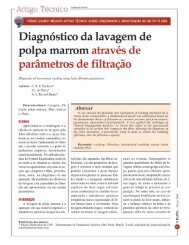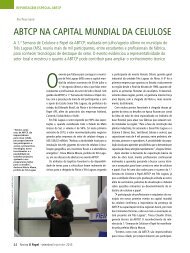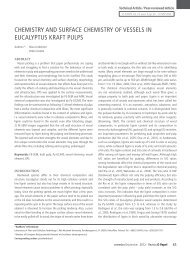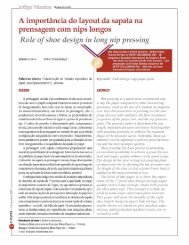Conhecimento é poder. - Revista O Papel
Conhecimento é poder. - Revista O Papel
Conhecimento é poder. - Revista O Papel
Create successful ePaper yourself
Turn your PDF publications into a flip-book with our unique Google optimized e-Paper software.
Economic Sector Article<br />
BY Ricardo Jacomassi,<br />
Chief Economist at Hegemony Projeções Econômicas<br />
: ricardo.jacomassi@hegemony.com.br<br />
sérgio brito<br />
Global economic projections<br />
The first consolidated figures on the world’s<br />
economy - divulged in these months of the<br />
first semester 2011 – showed a dividing<br />
point among key countries. This dividing point can<br />
be seen in the IMF’s (International Monetary Fund)<br />
projections for 2011 and 2012 regarding GDP (Gross<br />
Domestic Product) for the majority of economies.<br />
The x-ray extracted from the IMF’s figures showed<br />
a major shift in global growth – from rich nations<br />
to emerging markets -, with BRIC countries (Brazil,<br />
Russia, India and China), being the main drivers of<br />
global growth.<br />
According to the IMF, global GDP shall grow<br />
approximately 4.5% in 2011 and ca. 4.1% in 2012. On<br />
the ‘lower growth’ end, we see economies like Spain<br />
(0.8% - 2011 and 1.6% - 2012) and Italy (1.1% - 2011<br />
and 1.3% - 2012), while on the opposite side (higher<br />
GDP growth), we see China (9.6% - 2011 and 9.5%<br />
- 2012) and Brazil (4.5% - 2011 and 4.1% - 2012).<br />
For the world’s largest economy, United States, the<br />
IMF projects that the country will grow 2.8% in 2011<br />
and 2.9% in 2012, which rates surpass those of the<br />
European Union, of 1.6% and 1.8%, respectively. Such<br />
result reflects the weakening of Europe’s economy,<br />
hampered by high public indebtedness.<br />
Undermined by a global demand suppression,<br />
the industrial sector is showing moderate recovery.<br />
When comparing the first quarter of 2011 against<br />
the same period in 2010, industrial production grew<br />
6% in the Euro region, a rate similar to the 5%<br />
registered in the United States.<br />
Brazil’s industry did not excel and posted a 2%<br />
growth rate. The sector was negatively affected by<br />
the Central Bank’s macro-prudential measures and<br />
high currency exchange rate. In Japan, in addition<br />
to losing its status of biggest exporter worldwide<br />
to China, the country posted a 1% decrease in<br />
industrial production for the first quarter.<br />
However, in the monthly analysis (February-March<br />
2011), the drop amounted to 15.5%, which was due<br />
exclusively to the earthquake that damaged part of<br />
the industries of its main sectors, like automobiles.<br />
The unemployment rate, which is important in<br />
determining the dynamics of consumption, continues<br />
high in the European Union (9.9%). One of the reasons<br />
behind this high rate is the slow recovery in industrial<br />
production, without taking into account the fiscal<br />
crisis risk in some member countries. In the United<br />
States, the unemployment rate continues being one<br />
of the highest in history, near 9.0%, while the urban<br />
unemployment rate in China amounted to 4.1%.<br />
Accumulated inflation for the last 12 months is on<br />
the rise in the United States (3.2%) and the European<br />
Union (2.8%) and the worrying factor when looking at<br />
the reasons is that this high is being driven exclusively<br />
by an increase in commodity prices, rather than<br />
domestic consumption, which continues weak.<br />
The end of the first half of 2011 offers signs of how the<br />
global economy will behave over the next few months<br />
and underscores the fragility of developed economies<br />
with their disappointing economic indicators.<br />
Lastly, IMF projections point to a stable 2012 with<br />
little consistency, which leads us to believe that the<br />
risk of a new crisis still exists.<br />
•<br />
Graph – IMF Projections<br />
(%) – a.a.<br />
23<br />
18<br />
13<br />
8<br />
3<br />
-2<br />
Spain<br />
Source: IMF<br />
2012<br />
2011<br />
1.6<br />
0.8<br />
(-) lower<br />
growth<br />
1.3<br />
1.1<br />
Italy<br />
2.1<br />
1.4<br />
Japan<br />
1.8<br />
1.6<br />
Euro Area<br />
1.8<br />
1.6<br />
France<br />
2.1<br />
2.5<br />
Germany<br />
2.9<br />
2.8<br />
United States<br />
4.5<br />
4.4<br />
World Economic<br />
4.1<br />
4.5<br />
Brazil<br />
4.0<br />
4.6<br />
Mexico<br />
(+) higher<br />
growth<br />
4.5<br />
4.8<br />
Russia<br />
7.8<br />
8.2<br />
India<br />
9.5<br />
9.6<br />
China<br />
junho/june 2011- <strong>Revista</strong> O <strong>Papel</strong><br />
61

















